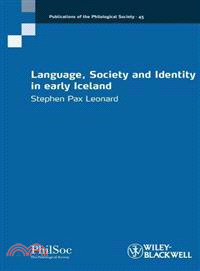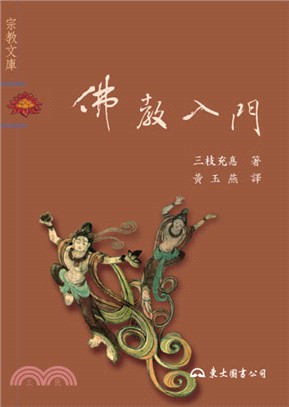相關商品
商品簡介
作者簡介
目次
商品簡介
Language, Society and Identity in early Iceland offers a much-needed exploration into the problem of linguistic and social identity construction in early Iceland, and is a fascinating account of an under examined historical-linguistic story that will spur further research and discussion amongst researchers.
* Engages with recent theoretical research on dialect formation and language isolation
* Makes a significant contribution to our understanding of dialect development, putting forward a persuasive hypothesis accounting for the lack of dialect variation in Icelandic
* Uses a unique, multi-disciplinary approach that brings together material from a wide range of fields for a comprehensive examination of the role of language in identity construction
* Opens up opportunities for further research, especially for those concerned with language and identity in Iceland today, where there is for the first time sociolinguistic variation
* Engages with recent theoretical research on dialect formation and language isolation
* Makes a significant contribution to our understanding of dialect development, putting forward a persuasive hypothesis accounting for the lack of dialect variation in Icelandic
* Uses a unique, multi-disciplinary approach that brings together material from a wide range of fields for a comprehensive examination of the role of language in identity construction
* Opens up opportunities for further research, especially for those concerned with language and identity in Iceland today, where there is for the first time sociolinguistic variation
作者簡介
Stephen Pax Leonard is a Fellow of Trinity Hall, Cambridge and a Research Associate at the Scott Polar Research Institute. Educated at the University of Oxford, he studied modern and ancient languages before developing interests in linguistic and existential anthropology. He has carried out both linguistic and ethnographic fieldwork in Iceland and the Faroe Islands. More recently, he spent a year living with the Inugguit of north-west Greenland who live in the northern-most permanently inhabited settlement in the world, documenting their vulnerable minority language and spoken traditions.
目次
1 Introduction1.1 Aims of the present study1.2 Organisation of study1.3 The settlement of Iceland1.4 The establishment of social structures1.5 The language of the Icelanders1.6 Sources 1.6.1 Historical texts 1.6.2 Religious works 1.6.3 Law codes 1.6.4 Grammatical Treatises 1.6.5 Poetry 1.6.6 Saga material2 Language and identity: theoretical considerations 2.1 Introduction2.2 Socio-historical linguistics and sociolinguistic theory2.3 Language change and norms 2.3.1 Intra-linguistic versus extra-linguistic explanations of language change2.4 Language and dialect contact 2.4.1 Dialect levelling and koineisation 2.4.2 Markedness in tabula rasa dialect-formation2.5 Language and dialect isolation 2.5.1 ‘Drift’2.6 Language development in tabula rasa societies 2.6.1 Language community types (and settlement patterns) 2.6.2 A deterministic model versus social factors 2.6.3 The Founder Principle and prestige2.7 Identity: essentialism versus constructivism 2.7.1 Personal identity and group membership 2.7.2 Place and identity2.8 Language and identity 2.8.1 Accommodation and networks 2.8.2 Accommodation Theory 2.8.3 Social network theory and language change 2.8.4 Deixis, pronouns and identity2.9 Conclusion3 Norm-establishment in Iceland 3.1 Introduction3.2 Norse dialectal variation prior to the Settlement 3.2.1 The runic evidence 3.2.2 Runic evidence and the spoken language3.3 The settlers: geographic origins and social mobility 3.3.1 The geographic origins of the settlers 3.3.2 Social background and mobility of the settlers 3.3.3 The status of Norse and Common Gaelic at the time of the Settlement3.4 Dialect features in Iceland, the Faroe Islands and south-west Norway3.5 Iceland as a ‘new society’ 3.5.1 Features of ‘new societies’3.6 Language development in early Iceland 3.6.1 The ‘mixture theory’ 3.6.2 Dialect levelling in early Iceland 3.6.3 The basis for koineisation3.7 Establishment of a linguistic norm in Iceland 3.7.1 Pre- and post-Settlement linguistic norms 3.7.2 Spoken norms and ‘standardised’ written languages 3.7.3 The establishment of a norm: skaldic poetry (and the laws) 3.7.4 The establishment of a norm: the role of the sagas3.8 The homogeneity of Icelandic 3.8.1 Background 3.8.2 Factors explaining the homogeneity of Icelandic3.9 Conclusion4 Social structures in the lexicon 4.1 Introduction4.2 Social identity and Icelandic social structures 4.2.1 Emerging social structures and identities 4.2.2 Characteristics of Icelandic social structures: role of the law 4.2.3 The significance of assembly-attachment4.3 Specific Icelandic social structures 4.3.1 hreppr (‘commune’) 4.3.2 bu´ar (‘neighbours’) 4.3.3 alþingi (‘General Assembly’) and lo¨gre´tta (‘Law Council’) 4.3.4 goðar (‘chieftains’)4.4 Individual identity and Icelandic kinship structures 4.4.1 landna´m (‘Settlement’) and kinship structures 4.4.2 Kinship and land-transfer 4.4.3 Genealogies and identity 4.4.4 Icelandic kinship terminology: cousin terms4.5 Conclusion5 Perception and use of language as an identity marker 5.1 Introduction5.2 Icelanders’ perceptions of foreign languages 5.2.1 References to a foreign language 5.2.2 References to Irish5.3 A vernacular identity: do¨nsk tunga, norræna and its speakers 5.3.1 The do¨nsk tunga as an identity marker 5.3.2 norræna as an identity marker 5.3.3 Norse dialectical variation and Anglo-Norse intelligibility5.4 Grammatical variables as identity markers 5.4.1 Agreeing possessive adjectives 5.4.2 Pronominal usage in the early Icelandic law codes 5.4.3 The ‘they’ 5.4.4 The ‘we’5.5 Spatial references: the issue of identity 5.5.1 Spatio-directional particles 5.5.2 Idiomatic use of spatial grammar 5.5.3 Semantics of orientation: the Norwegian system 5.5.4 Semantics of orientation: the Quarter-based system5.6 Conclusion6 Conclusion References Index
主題書展
更多
主題書展
更多書展本週66折
您曾經瀏覽過的商品
購物須知
外文書商品之書封,為出版社提供之樣本。實際出貨商品,以出版社所提供之現有版本為主。部份書籍,因出版社供應狀況特殊,匯率將依實際狀況做調整。
無庫存之商品,在您完成訂單程序之後,將以空運的方式為你下單調貨。為了縮短等待的時間,建議您將外文書與其他商品分開下單,以獲得最快的取貨速度,平均調貨時間為1~2個月。
為了保護您的權益,「三民網路書店」提供會員七日商品鑑賞期(收到商品為起始日)。
若要辦理退貨,請在商品鑑賞期內寄回,且商品必須是全新狀態與完整包裝(商品、附件、發票、隨貨贈品等)否則恕不接受退貨。
























